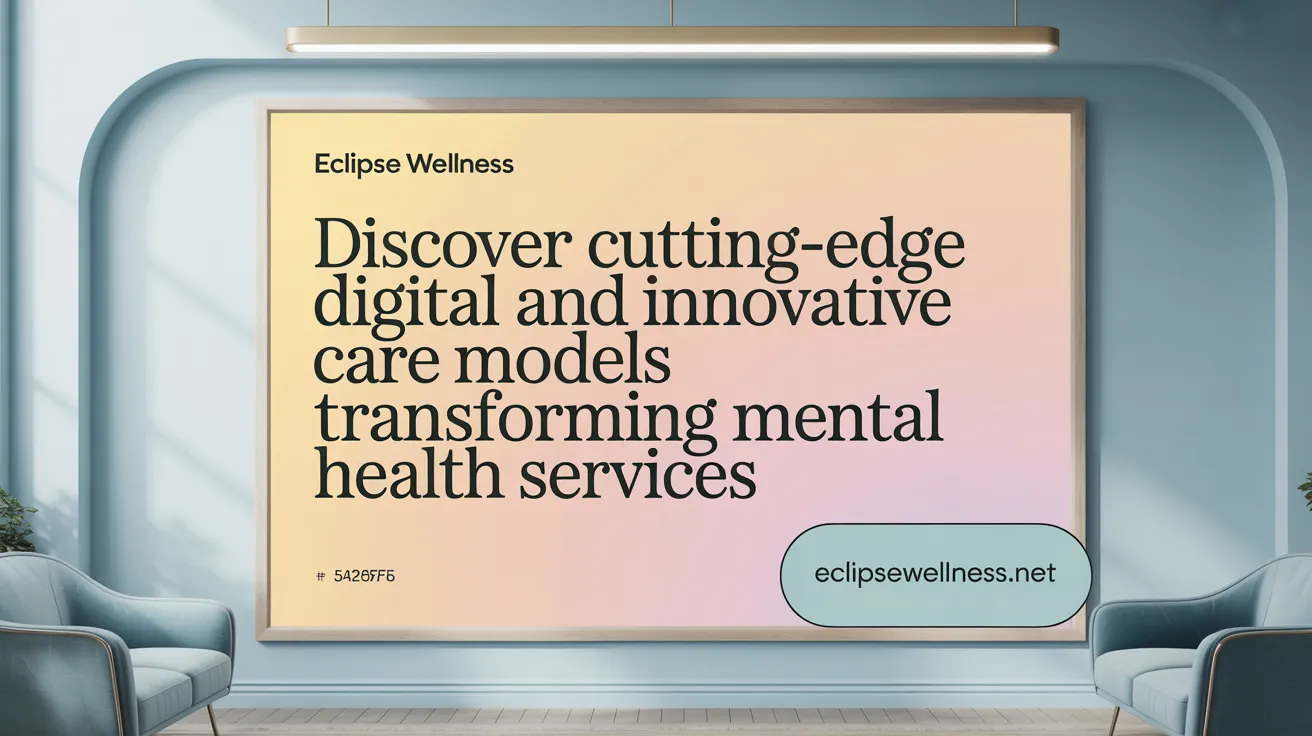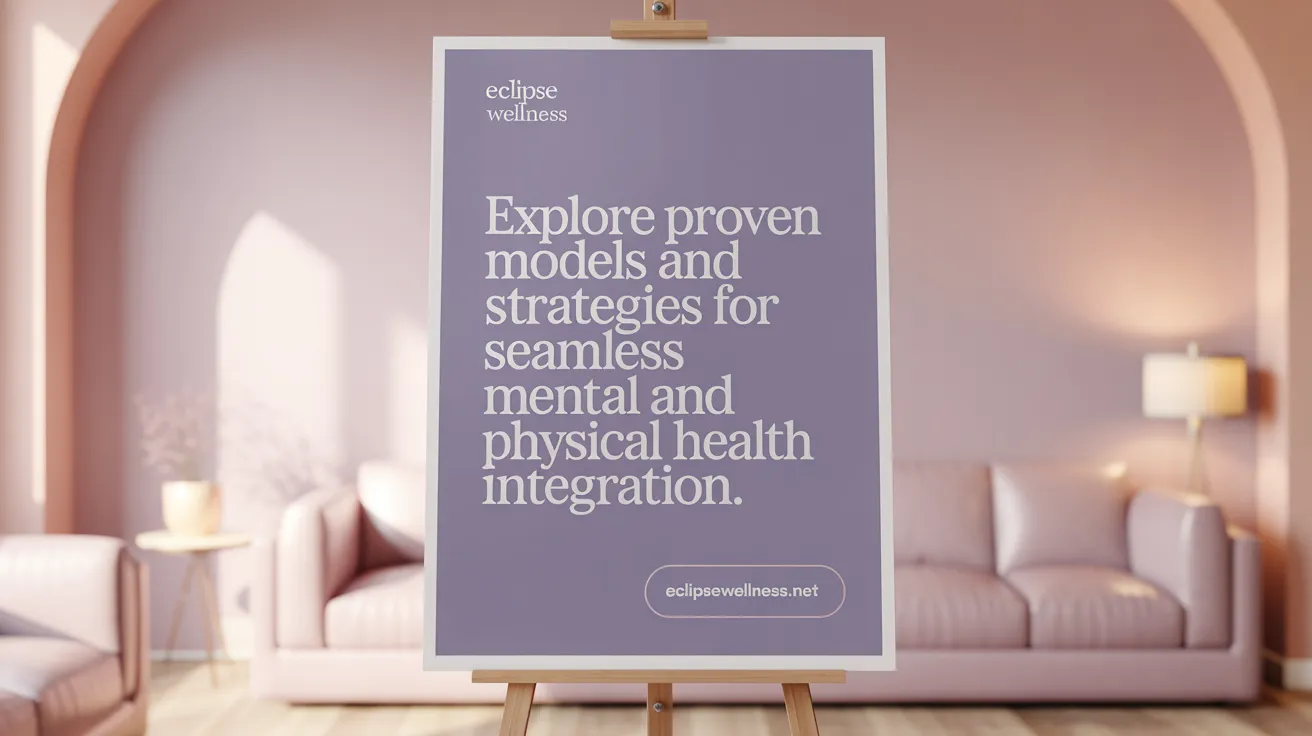The New Frontier in Mental Health Integration
Integrated care models and technological advancements are reshaping mental health services, offering holistic, accessible, and coordinated support for diverse populations. This article explores recent innovations, frameworks, and holistic approaches advancing the integration of mental health and physical healthcare, while highlighting cutting-edge digital tools, AI roles, and policy initiatives that promote equity and scalability.
Recent Innovations and Digital Transformations in Integrated Mental Health Care

Innovations in integrated mental health care
Recent developments in the field of mental health integration emphasize the significant role of digital technology and innovative care models. The adoption of comprehensive, evidence-based approaches like the Innovation in Behavioral Health (IBH) Model exemplifies efforts to connect behavioral and physical health services more effectively. New frameworks for integrated care implementation support team-based, population-focused, and patient-centered care delivery, with a focus on reducing disparities among vulnerable populations (mental health disparities and integrated care).
Technological advancements have also transformed how mental health services are delivered and monitored. Mobile mental health support applications enable self-management, symptom tracking, and passive sensing of behaviors, providing clinicians with real-time data for early intervention (Passive sensing technologies for mood prediction). Platforms supporting telepsychiatry and remote care provide expanded access, especially in underserved or rural communities (Telecare and therapeutic video games).
Digital tools and technology advancements
Modern tools include AI algorithms for diagnosis, personalized treatment planning, and risk prediction, often integrating data from wearables, social media activity, and electronic health records. AI-driven diagnostics utilize natural language processing (NLP), facial analysis, and voice recognition to detect early signs of mental health issues (Artificial Intelligence in mental healthcare). Virtual reality (VR) and augmented reality (AR) are being explored for immersive therapy sessions, exposure therapy, and trauma treatment, enhancing engagement and therapeutic outcomes (VR for anxiety and PTSD, Virtual reality in mental health care).
Telehealth and remote delivery platforms
The COVID-19 pandemic accelerated the adoption of telehealth platforms, making remote counseling and psychiatric services a staple of mental health care. These platforms offer synchronous video sessions, asynchronous digital interventions, and digital support roles like navigators to improve digital literacy and engagement (Hybrid care in mental health). Efforts are focused on creating scalable models that uphold quality and safety standards.
AI-enabled diagnosis and treatment
Artificial intelligence is increasingly applied to predict psychiatric risks, monitor patient progress, and tailor interventions. Tools analyze speech, text, and physiological signals, facilitating early detection, relapse prevention, and personalized therapy adjustments (AI applications for early detection). Virtual therapists and chatbots provide accessible, stigma-free support, supplementing traditional care (Mental health chatbots Woebot and Wysa).
Examples of emerging technology applications
Innovations include generative AI models that support clinical decision-making, VR-based exposure therapies for PTSD, and digital phenotyping techniques that passively monitor mental health states through sensors (Digital tools in mental health treatment). Digital therapeutics like apps for cognitive-behavioral therapy (CBT) are undergoing validation for safety and efficacy (digital therapeutics for mental health).
Regulatory and safety guidelines development
Recognizing the rapid growth of digital mental health tools, regulatory bodies are developing safety, privacy, and efficacy guidelines. Agencies endorse app certifications, data security protocols, and clinical standards to ensure that innovations are safe and evidence-based (APA App evaluation framework, FDA oversight). Platforms like the APA App Evaluation framework and FDA oversight are guiding responsible deployment of these technologies.
In summary, ongoing innovations, supported by regulatory advancements, are creating a robust, scalable digital ecosystem that complements integrated behavioral health treatments. These developments hold promise for expanding access, improving personalized treatment, and enhancing outcomes, though challenges related to standardization and bias remain to be addressed.
Models and Frameworks for Integrating Mental and Physical Health Care
 Current approaches to integrating mental and physical health services primarily include the Collaborative Care Model (CoCM) and the Primary Care Behavioral Health Model (PCBH). These models promote team-based, patient-centered care within primary care settings, emphasizing the importance of collaborative approaches for better health outcomes.
Current approaches to integrating mental and physical health services primarily include the Collaborative Care Model (CoCM) and the Primary Care Behavioral Health Model (PCBH). These models promote team-based, patient-centered care within primary care settings, emphasizing the importance of collaborative approaches for better health outcomes.
The continuum of integration ranges from coordinated and colocated services, where providers operate separately but share information, to fully integrated teams that develop shared treatment plans and conduct population health management collectively. This spectrum allows flexibility in implementation based on practice resources and patient needs as described in integrated behavioral health treatments and integrated care principles.
Evidence-based screening tools such as the PHQ-9 for depression and the GAD-7 for anxiety are essential for early detection and continuous monitoring of mental health conditions, supported by evidence-based integrated care. Interventions like Motivational Interviewing and Screening, Brief Intervention, and Referral to Treatment (SBIRT) support behavioral change and timely care engagement.
Government-led initiatives, including the recently launched Innovation in Behavioral Health (IBH) Model, aim to embed behavioral health into Medicaid and Medicare services. These initiatives promote person-centered, integrated care by fostering care coordination, expanding health information technology (HIT) infrastructure, and actively addressing social determinants of health to reduce disparities.
Overall, these models emphasize enhancing communication, leveraging technology in integrated care, and promoting holistic, patient-centered approaches, to bridge gaps between mental and physical health services for improved outcomes.
Holistic and Integrative Therapies Enhancing Mental Health Support
 Holistic and integrative mental health care employs a variety of practices supported by scientific research that focus on treating the whole person—including their body, mind, spirit, and emotions. Evidence-based approaches such as cognitive-behavioral therapy (CBT), mindfulness-based stress reduction (MBSR), and acceptance and commitment therapy (ACT) form the foundation for psychological treatment, helping individuals manage symptoms, develop coping skills, and foster resilience (Integrative Medicine and Health, Integrative medicine in psychiatry, Holistic approaches in integrated psychological care).
Holistic and integrative mental health care employs a variety of practices supported by scientific research that focus on treating the whole person—including their body, mind, spirit, and emotions. Evidence-based approaches such as cognitive-behavioral therapy (CBT), mindfulness-based stress reduction (MBSR), and acceptance and commitment therapy (ACT) form the foundation for psychological treatment, helping individuals manage symptoms, develop coping skills, and foster resilience (Integrative Medicine and Health, Integrative medicine in psychiatry, Holistic approaches in integrated psychological care).
Complementary therapies play a significant role in this comprehensive approach. Art therapy, which includes drawing, painting, music, and sculpting, allows individuals to express feelings and foster self-awareness. Yoga integrates physical movement, breathing, and meditation to reduce stress and promote emotional regulation. Equine therapy, involving interactions with horses, can develop self-esteem, mindfulness, and empathy, which are beneficial for mental health and substance use recovery. Recreational activities such as sports, dance, and dramatization further assist in stress reduction and social connection (Holistic mental health treatment, Holistic well-being).
Mindfulness and nutritional strategies are also integral. Mindfulness practices like meditation and biofeedback help ground individuals in the present moment, reducing anxiety and depressive symptoms. Nutritional support—such as omega-3 fatty acids, vitamins, and probiotics—addresses underlying physical imbalances that can influence mood and cognitive function (Integrative Medicine and Health, Integrative medicine in psychiatry).
Integrative medicine combines conventional treatments with these holistic modalities, including traditional systems like Chinese medicine and Ayurveda. This personalized care aims to uncover and treat the root causes of emotional distress—be it trauma, nutritional deficiencies, or physical health issues—while fostering emotional, spiritual, and physical well-being (Integrative Medicine and Health, Integrative mental health).
Patient-centered, whole-person care respects individual cultural backgrounds and preferences, ensuring tailored interventions that encompass lifestyle factors like diet, exercise, and sleep hygiene. The synergy of evidence-based psychotherapy with holistic modalities creates a supportive framework for sustainable mental health improvement, emphasizing self-care, resilience, and overall well-being (Holistic mental health care, Holistic mental health approach).
The Role of Artificial Intelligence and Hybrid Care Models in Mental Health
Artificial intelligence (AI) is transforming mental health care by enabling early diagnosis, personalized treatment, and continuous monitoring of mental health conditions. Techniques such as Natural Language Processing (NLP) and facial expression analysis allow clinicians and AI systems to analyze speech, social media activity, and visual cues, leading to early detection of issues like depression or anxiety. AI-driven tools like chatbots—Woebot and Wysa—offer accessible, stigma-free support, delivering evidence-based therapies including cognitive-behavioral therapy (CBT) around the clock, especially benefiting underserved populations.
In treatment, AI personalizes care plans by integrating genetic, behavioral, and physiological data, supporting more targeted and effective interventions. During teletherapy, AI systems monitor emotional and physiological states in real-time to adapt therapeutic approaches, increasing engagement and outcomes. Wearable devices complement this by tracking sleep, activity, and other health indicators, enabling early identification of deterioration or relapse and facilitating prompt intervention.
Emerging trends highlight the adoption of hybrid care models that combine digital tools with human support. These models extend access through telepsychiatry, mobile health apps, and remote monitoring—reducing barriers such as distance, time, and stigma. Digital navigators are increasingly employed to assist patients with engaging with and navigating digital health platforms, ensuring sustained participation.
Advanced technologies like virtual reality (VR) and augmented reality (AR) are used for immersive therapeutic experiences, especially for trauma and phobias, while digital phenotyping collects behavioral data to inform personalized care. As these innovations evolve, considerations around data privacy, ethical use, and regulatory oversight remain vital to ensure safe and equitable deployment, ultimately fostering more effective, accessible, and patient-centered mental health services.
Policy, Payment Reforms, and Systemic Approaches Advancing Integration
Several policy initiatives and systemic approaches are actively supporting the integration of mental health services into broader healthcare systems. Governments and health agencies have promoted mandates that encourage collaborative care models, emphasizing mental-physical health parity and the importance of comprehensive, coordinated care. Reimbursement systems are being reformed to better support integrated approaches, moving away from fee-for-service models toward innovative payment models like case rates, bundled payments, and outcome-based reimbursements. For instance, recent programs such as the CMS Innovation in Behavioral Health (IBH) Model are designed to promote infrastructure payments, value-based care, and practice transformation to improve access and quality for Medicaid and Medicare populations.
Moreover, expanding health information technology (IT) infrastructure plays a pivotal role in facilitating seamless data sharing and coordination among providers. Initiatives like the US Core Data for Interoperability (USCDI+BH) and the development of behavioral health-specific EHR modules are enhancing the capacity for integrated care delivery, patient engagement, and outcome measurement.
Workforce training and community collaboration are critical components of systemic reform. Efforts include developing digital health competencies, expanding the behavioral health workforce through targeted training, and embedding mental health services within primary care, schools, and community settings to reduce disparities. These strategies are vital for addressing social determinants of health, such as economic stability, housing, and social support, which significantly impact mental health outcomes (SAMHSA behavioral health support resources).
Despite these advances, barriers persist, including resistance to practice change, limited funding, and workforce shortages, particularly in underserved communities. Overcoming these challenges requires multipayer incentives, robust policy reforms, and cross-sector collaboration between healthcare, education, social services, and community organizations (barriers to integrated care implementation).
In sum, advancing mental health integration depends on a comprehensive approach that combines policy reforms, innovative payment models, technology enhancement, and community engagement. These systemic efforts aim to create accessible, preventative, and holistic care that meets diverse population needs, ultimately reducing disparities and improving long-term mental health outcomes (evidence-based integrated care).
Innovations Promoting Equity and Supporting Vulnerable Populations

What innovations address health equity and support youth and vulnerable populations in mental health care?
Efforts to advance health equity in mental health encompass a wide array of innovative programs and strategies designed to reach underserved and marginalized groups. Culturally tailored interventions are central, involving programs that are adapted to reflect the specific cultural, linguistic, and contextual needs of diverse populations. These initiatives ensure that care is accessible, relevant, and respectful of individuals’ backgrounds.
Community-based and peer support models also play a vital role, embedding mental health services within local settings such as schools, faith communities, and community centers. These models leverage the trust and familiarity of community members, making mental health support more approachable. Peer-led interventions further empower individuals with lived experience to guide others, reducing stigma and fostering a sense of belonging.
Digital health innovations are expanding rapidly, offering new avenues for equitable access. Telepsychiatry, internet-delivered cognitive-behavioral therapy, and AI-powered apps help bridge geographical and socioeconomic barriers. For example, the UNICEF Mental Health Innovation Portfolio incorporates digital tools such as chatbots and mobile apps tailored for adolescents and youth in underserved regions, addressing issues related to access, stigma, and social determinants.
Policy efforts, including legislation like the Mental Health Parity Act and broadband expansion initiatives, are designed to create an enabling environment for equitable care. These policies aim to reduce disparities by ensuring coverage, increasing infrastructure, and promoting inclusive health care practices.
Organizations like the UCLA Center on Depression and Resilience employ digital phenotyping—using data from smartphones and wearables—to detect early signs of distress among marginalized groups, facilitating timely interventions. Inclusive development processes, involving communities directly in designing digital solutions, ensure technological tools are accessible and culturally appropriate.
Looking forward, the emphasis is on creating personalized, culturally sensitive, and ethically sound digital interventions. These efforts include ongoing monitoring to evaluate effectiveness and equity, encouraging multi-sector partnerships that integrate education, health, technology, and social services. Such collaborations help close persistent gaps, ensuring vulnerable populations—particularly youth, people of color, and those in remote or socioeconomically disadvantaged settings—receive the compassionate, effective mental health care they deserve.
More info search query
Mental health equity innovations for youth and vulnerable groups
This exploration indicates a growing commitment to reducing disparities through culturally competent, community-anchored, and technology-enabled mental health solutions. The ongoing development and evaluation of these innovations promise a future where high-quality, equitable mental health care is accessible for all, irrespective of social or economic barriers. For further details, see resources on mental health equity and integrated behavioral health treatments, digital mental health interventions for underserved communities, technology in mental health care, and mental health innovation projects focusing on youth and vulnerable populations.
Looking Ahead: Sustaining Innovation in Integrated Mental Health Care
As integrated mental health care continues to evolve, innovations spanning technology, holistic therapies, and collaborative models are breaking new ground in improving access, personalization, and outcomes. Policy shifts and payment reform initiatives like the Innovation in Behavioral Health Model support scaling and sustainability, while attention to equity ensures that youth and vulnerable populations receive tailored care. Embracing AI and hybrid care frameworks alongside evidence-based holistic practices promises a future where mental health support is comprehensive and accessible. Continued research, investment, and collaboration across sectors will be essential to realize the full potential of these innovations, advancing mental health care toward a more integrated, effective, and inclusive paradigm.
